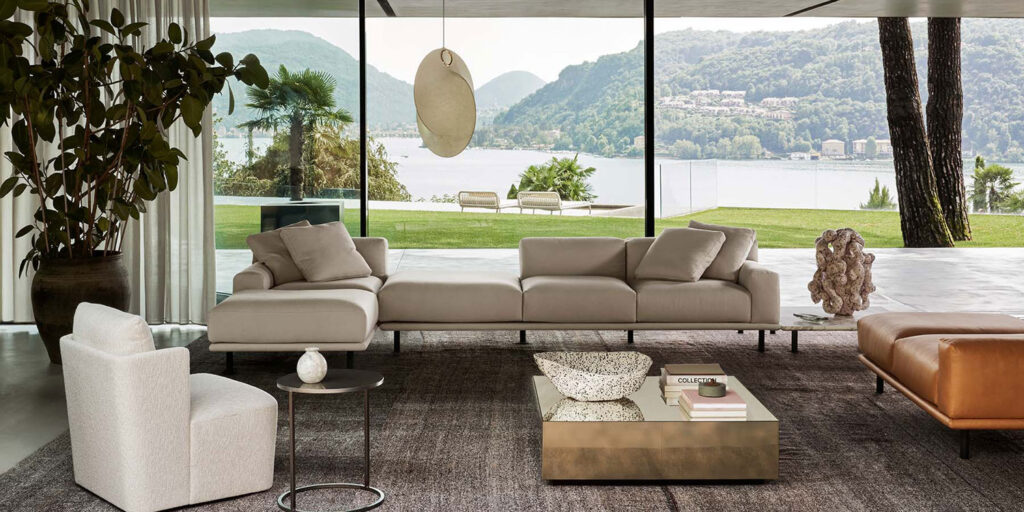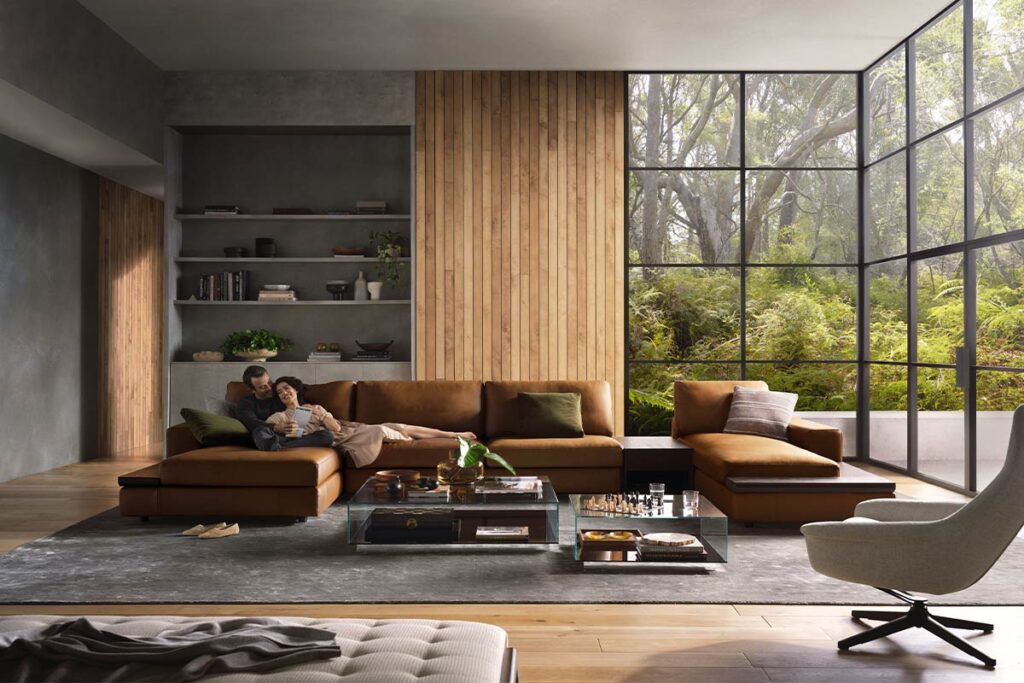Leather sofas have long been regarded as a hallmark of luxury and sophistication in home decor. They offer a perfect blend of comfort, durability, and style, making them a staple in many households. In this article, we will explore the appeal of leather sofas, their durability, how to choose the right one, maintenance tips, and their environmental impact.
Understanding the Appeal of Leather Sofas
Leather sofas possess a unique allure that makes them a popular choice amongst homeowners. Their combination of style and functionality contributes significantly to their enduring appeal.
The History of Leather Furniture
The use of leather in furniture dates back thousands of years, with early examples found in ancient civilizations such as Egypt and Rome. Initially, leather was utilized for its availability and strength. As time progressed, it became a symbol of status and luxury, often featured in the homes of the wealthy.
In the 18th and 19th centuries, the art of leatherworking advanced significantly, allowing artisans to create more intricate designs and higher-quality pieces. This evolution established leather furniture as a staple in both classic and contemporary home design.
Moreover, the Industrial Revolution brought about mass production techniques that made leather furniture more accessible to the middle class. This democratization of leather products led to a surge in popularity, with many families opting for leather sofas as a durable and stylish choice for their living spaces. Today, leather furniture continues to evolve, incorporating modern technology and sustainable practices to meet the demands of contemporary consumers.
The Aesthetic Versatility of Leather
One of the most appealing aspects of leather sofas is their aesthetic versatility. Leather can seamlessly integrate into various design styles, from rustic to modern.
Available in numerous colors, textures, and finishes, leather provides homeowners with choices that suit their personal style. Whether it’s a sleek black sofa in a contemporary living room or a distressed brown piece in a cozy lodge, leather’s ability to complement different environments is unparalleled.
Additionally, leather’s natural patina develops over time, adding character and depth to the furniture. This aging process not only enhances the beauty of the piece but also tells a story of its journey through life. Many homeowners appreciate how leather can adapt to their evolving tastes, making it a timeless investment that can transition with changing design trends. From minimalist settings to eclectic interiors, leather sofas can serve as a striking focal point or a subtle complement, proving their versatility in any space.
The Durability of Leather Sofas
When investing in furniture, durability is a crucial factor to consider. Leather sofas, when properly cared for, can withstand years of use, making them a wise investment for any home.

Leather’s Resistance to Wear and Tear
Leather is renowned for its resilience. Unlike fabric upholstery, which can fray or fade over time, high-quality leather can resist wear and tear remarkably well. Its natural composition allows it to age beautifully, developing a unique patina that adds character to the furniture.
This durability makes leather an ideal choice for families with children or pets, as it is less prone to damage from spills or scratches compared to other materials. Additionally, leather’s non-porous surface makes it easier to clean; a simple wipe with a damp cloth can often remove stains, unlike fabric which may require more intensive cleaning methods. This ease of maintenance not only preserves the sofa’s appearance but also contributes to a healthier living environment by minimizing allergens and dust accumulation.
Long-term Value of Leather Furniture
From a financial perspective, leather sofas can offer long-term value that surpasses other types of upholstery. While the initial investment may be higher than that of fabric sofas, their longevity can make up for this cost over time.
When looking at the total cost of ownership, including replacement expenses and maintenance, leather sofas can ultimately prove to be more economical. Buyers should consider leather as a smart investment that retains its value and appeal. Furthermore, leather furniture often enhances the aesthetic of a home, adding a touch of sophistication and elegance that can elevate any room’s decor. As trends in interior design shift, leather remains a timeless choice, ensuring that your investment continues to look stylish and relevant for years to come.
Choosing the Right Leather Sofa for Your Home
With a myriad of options available, selecting the perfect leather sofa can feel overwhelming. However, understanding a few key aspects can simplify the decision-making process.
Assessing Leather Quality
Not all leather is created equal. When assessing leather quality, it’s important to understand the different grades available. Full-grain leather is the highest quality, showcasing the natural markings and texture of the hide, while corrected-grain leather is altered to remove imperfections.
Opting for higher-grade leather will yield a more durable and visually appealing product. Always check the manufacturer’s specifications and choose a reputable brand known for their craftsmanship. Furthermore, consider the tanning process used for the leather. Vegetable-tanned leather is more environmentally friendly and develops a beautiful patina over time, while chrome-tanned leather is more resistant to wear and tear, making it a practical choice for families with pets or young children. Read more about how to choosing the best leather quality at https://ui.adsabs.harvard.edu/abs/2024CEngT..2200807T/abstract
Matching Sofa Styles to Your Interior Design
Your leather sofa should enhance your home’s aesthetic. Before making a purchase, consider the existing design elements in your space. Traditional homes may benefit from classic Chesterfield styles, while modern spaces may call for sleek, minimalist designs.
Additionally, take into account the color palette of your room. A deep burgundy or rich chocolate brown leather can add warmth, while a gray or cream piece can create a cooler, contemporary feel. It’s also worth considering how the sofa’s shape and size will interact with the other furniture in the room. A sectional sofa can be a great choice for larger spaces, providing ample seating and a cozy atmosphere, while a streamlined loveseat might be ideal for smaller areas, ensuring that the space feels open and inviting. Don’t forget to think about the layout; the placement of your sofa can greatly influence the flow and functionality of your living area, so take the time to visualize how it will fit into your home before making a final decision.
Maintaining Your Leather Sofa
Caring for your leather sofa is essential to preserve its beauty and longevity. With the right maintenance routine, your investment will continue to look stunning for years. Leather, being a natural material, requires a bit of attention to keep it looking its best, but the rewards are well worth the effort.
Cleaning and Conditioning Tips
Regular cleaning is key to maintaining your leather sofa. Use a soft, damp cloth to wipe away dust and debris. For deeper cleansing, a specialized leather cleaner can be employed. It’s important to test any cleaner on a hidden area first to ensure it doesn’t alter the color or texture of the leather. Additionally, avoid using harsh chemicals or abrasive materials, as these can damage the surface.
Additionally, conditioning the leather every six to twelve months with a quality leather conditioner will prevent cracking and maintain its suppleness. This step is vital to ensure the leather remains in optimal condition. Conditioning not only nourishes the leather but also creates a protective barrier against dirt and moisture, which can lead to deterioration over time. Make sure to apply the conditioner evenly and allow it to absorb fully for the best results.
Protecting Leather from Damage
While leather is inherently durable, it can still be susceptible to damage from direct sunlight and sharp objects. Placing your sofa away from direct sunlight can prevent fading, whereas avoiding sharp-edged objects will reduce the risk of scratches. Consider using window treatments to filter sunlight during peak hours, which can greatly extend the life of your leather.
Using coasters and avoiding food and drink spills will also protect your leather from potential stains. Following these precautions will help keep your leather sofa looking pristine. In addition, consider using a leather protector spray that can provide an extra layer of defense against spills and stains. Regularly inspecting your sofa for any signs of wear or damage allows you to address issues promptly, ensuring your leather remains as beautiful as the day you brought it home. Remember, a little proactive care goes a long way in maintaining the elegance of your leather furniture. T o learn more about maintaining leather sofas click here.
The Environmental Impact of Leather Sofas
While leather sofas offer numerous benefits, it is crucial to understand their environmental impact as well. The production of leather involves several processes that can raise concerns among consumers.

Leather Production and Sustainability
The leather tanning process can result in significant environmental pollution. However, many manufacturers are adopting more sustainable practices, including vegetable tanning and the use of recycled water, to mitigate their ecological impact. These innovative methods not only reduce harmful chemical runoff but also promote a more circular economy within the leather industry. By utilizing natural tannins derived from plant sources, these processes minimize the carbon footprint associated with traditional tanning methods, which often rely on toxic substances like chromium.
Moreover, leather is a natural product that biodegrades over time, offering a more sustainable option compared to synthetic materials. Understanding the source of your leather and the environmental policies of the manufacturer can aid in making an informed choice. Additionally, some companies are now focusing on sourcing leather from farms that practice regenerative agriculture, which enhances soil health and biodiversity. This approach not only supports sustainable livestock farming but also contributes positively to the ecosystem.
Leather vs. Synthetic Materials: A Comparison
The debate between leather and synthetic materials is ongoing. While synthetic fabrics may initially appear more environmentally friendly, they are often made from petroleum-based materials that are non-biodegradable. The production of these synthetic alternatives can also be energy-intensive, contributing to greenhouse gas emissions. Furthermore, the microplastics released during the washing of synthetic fabrics pose a significant threat to marine life and water quality, making the environmental cost of these materials more complex than it seems at first glance.
Leather, on the other hand, offers a natural, breathable alternative that can combine luxury with ecological responsibility if sourced sustainably. Evaluating the pros and cons of both options can help you make decisions that align with your values and preferences. It’s also worth noting that leather, when cared for properly, can last for decades, reducing the need for frequent replacements and the associated waste. This longevity not only makes leather a practical choice but also a more environmentally sound investment in the long run.
In addition, the rise of alternative leather options, such as those derived from mushrooms or pineapple leaves, is reshaping the conversation around sustainable upholstery. These innovative materials aim to provide the same aesthetic appeal as traditional leather while significantly reducing the environmental impact. As consumers become more aware of their choices, the market for eco-friendly alternatives continues to expand, offering more options for those looking to balance style with sustainability.
In conclusion, leather sofas serve as a timeless investment for any home. Their aesthetic appeal, exceptional durability, and potential longevity make them a smart choice for discerning homeowners. Careful selection and maintenance will ensure your leather sofa remains a cherished part of your home for years to come.
Related : How to Maintain a Leather Sofa for Long-Lasting Elegance
